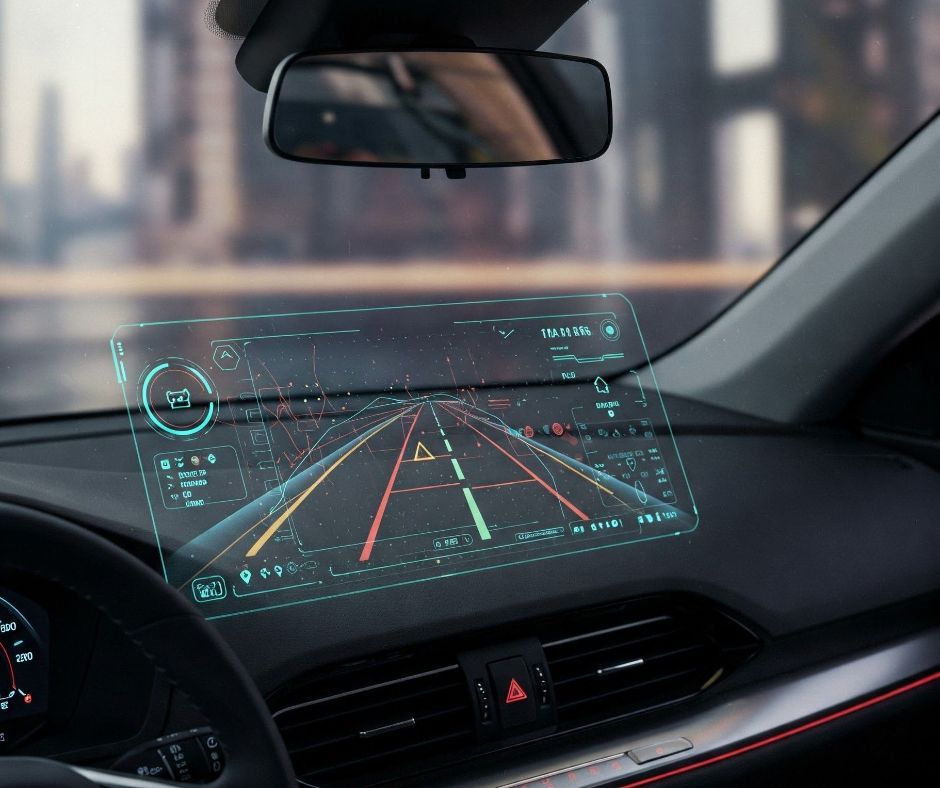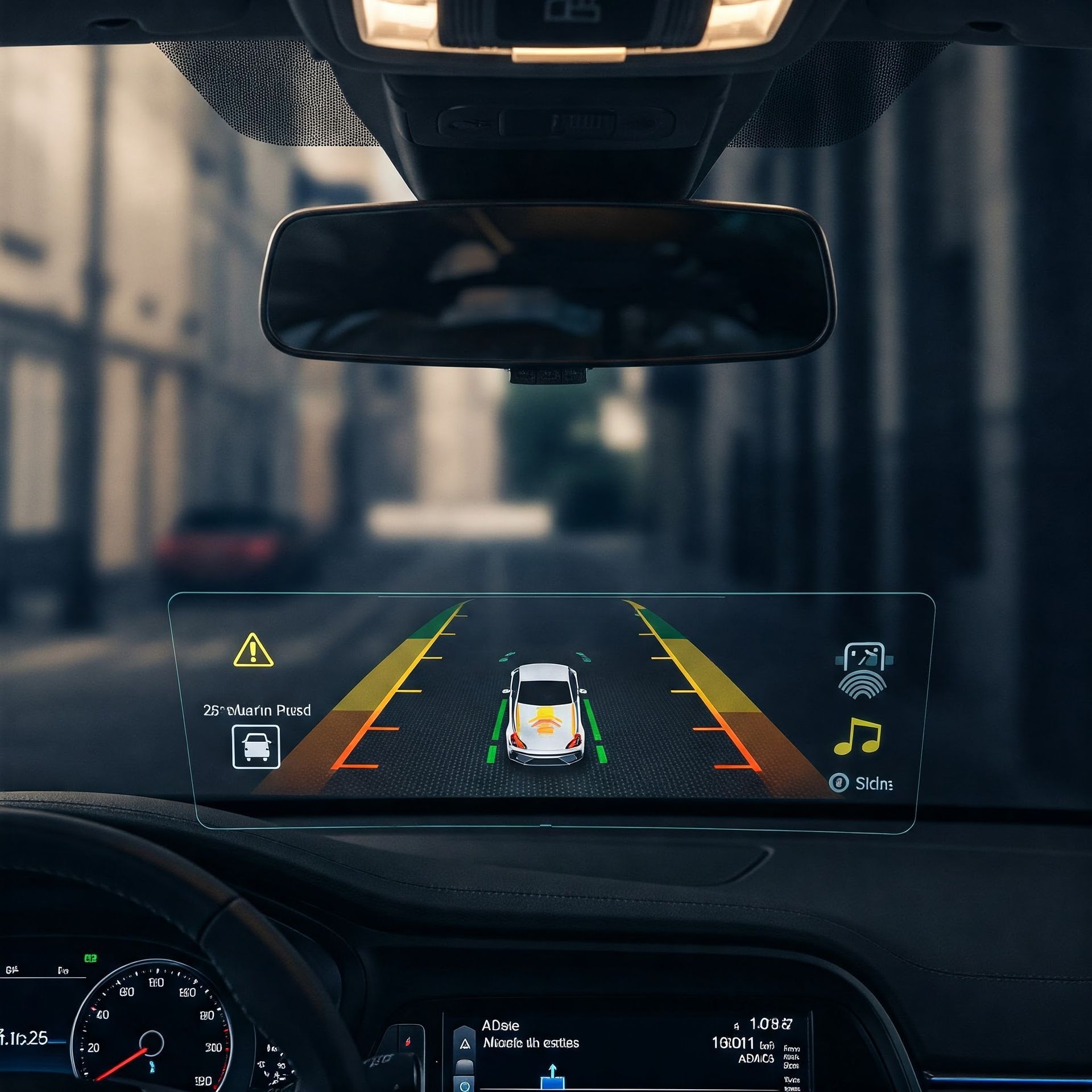Blog Layout
"Your Windshield: Now Smarter Than Your Smartphone (Maybe)."
Doug Stockman • April 3, 2025
Windshields Now Require Calibration For Automobile Warning Systems.


Alright, buckle up buttercup, because we're diving headfirst into the shimmering, slightly terrifying world of smart windshields and their heads-up displays (HUDs). It's like your car decided to get a PhD in "Projecting Slightly Distracting Information Directly Into Your Field of Vision."
My Windshield Thinks It's a Sci-Fi Movie (and I'm the Confused Extra)
Let's be honest, the concept is undeniably cool. A windshield that whispers directions, flashes speed limits, and warns you about rogue squirrels darting across the road. Sounds like something out of a futuristic car chase, right? Except, in my case, it's more like a confused robot trying to give me stock market updates while I'm attempting to parallel park.
"Warning: Pedestrian detected!" my windshield shouts, just as I'm squinting to read a tiny street sign. "Also, your portfolio is down 2%." Thanks, windshield. I'm already stressed enough trying not to curb my rims; I don't need a financial existential crisis right now.
The HUD, in theory, is supposed to make driving safer. No more glancing down at your phone or dashboard! Instead, vital information is projected directly onto the glass, like a holographic fairy godmother guiding you through traffic. In reality, it's more like a pixelated ghost trying to play charades with road signs.
"Is that a speed limit of… 35? Or is it a glitchy jellyfish?" I ponder, as the numbers shimmer and dance before my eyes.
Replacing Your Smart Windshield: A Journey Through the Valley of Tears (and Wallets)
Now, let's talk about the delightful process of replacing one of these high-tech marvels. It's like replacing a regular windshield, but with the added bonus of feeling like you're dismantling a small satellite.
First, you'll need to find a specialist who knows how to handle these delicate, digital darlings. Not your average "Chip-Fix-It" guy. We're talking about someone who can probably also reprogram a Mars rover.
Then, there's the cost. Brace yourself, because it's not going to be cheap. Imagine taking your standard windshield replacement price, multiplying it by the number of pixels on your display, and then adding a "because it's fancy" tax.
"So, that'll be… your firstborn child, your left kidney, and a small island in the Pacific," the technician says, with a perfectly straight face. Miraculously, if some rogue pebble, suicidal bird, or maybe even a tiny, angry alien laser caused that starry-night effect on your glass, and if your insurance deems it a "covered peril", then Hallelujah! You might just escape wallet-lightening.
And hold onto your hats, folks, because South Carolina, in its infinite wisdom, has decided that safety glass is so important, they're basically saying, "Deductibles? We don't know her." That's right, the state's like, "We're throwing a glass-fixing party, and YOU'RE invited, free of charge!" (Provided, of course, you've been a responsible adult and shelled out for that "comprehensive coverage." If you haven't, well, let's just say you'll be seeing stars in more ways than one.)
The actual replacement process involves a symphony of wires, sensors, and delicate calibration. It's like watching a surgeon perform open-heart surgery on your car's face. One wrong move, and your HUD will start projecting cat videos instead of navigation.
The Moral of the Story?
Smart windshields are undeniably impressive, but they come with a hefty dose of "what could possibly go wrong?" It's like having a tiny, demanding computer living in your car's face.
So, the next time your windshield starts giving you stock tips or displaying existential road signs, just remember: you're not alone. We're all in this pixelated, slightly confusing future together. And if you ever need to replace it, just remember to sell a kidney first.

By Doug Stockman
•
April 1, 2025
Alright, groovy cats and kittens! Buckle up your bell-bottoms, 'cause we're about to take a far-out trip down the cosmic highway of auto insurance! We're talkin' about the wild, wonderful world of saving your hard-earned bread on that groovy ride of yours. Far Out, Man! Unraveling the Mystical Maze of Auto Insurance Discounts (and Avoiding a Pricey Freak-Out) Let's face it, dig? Adulting can be a real mind-bender. You got bills piling up like a mountain of tie-dye, responsibilities that weigh you down, and that nagging feeling that you've misplaced your peace sign (or your keys, man, again!). And then there's the whole scene with auto insurance. It's like a financial hug you didn't ask for, but hey, you gotta roll with it, right? But don't let those insurance company vibes bum you out, my friend! In the midst of all that jargon and those confusing clauses that make your head spin like a psychedelic record, there's a glimmer of sunshine, a little patch of daisies in a field of paperwork: DISCOUNTS! Yeah, those magical little reductions that can make your monthly payment feel less like a cosmic rip-off and more like a mellow groove. Insurance companies have cooked up more discount categories than there are flavors of organic granola. So, let's take a humorous (and maybe a little cynical, man, you know how it is) look at some of the most far-out ones: The "Keep Your Wheels on the Ground, Dude" Discount: This one's pretty straight-up, man. Don't crash your groovy machine, don't zoom around like a speed freak, and generally don't act like a hyperactive squirrel hopped up on too much coffee behind the wheel, and you might just get a little pat on the back (and a discount!). It's like being rewarded for... not being a total menace to society. Groovy, baby, groovy. The "More Wheels, More Savings, Man!" Discount: Dig this, if you're lucky enough to own more than one set of wheels, they think you're some kind of responsible guru capable of juggling multiple things at once. Or maybe it just means they can squeeze a few more clams out of ya. Either way, if you've got a fleet of vintage vans (or even just two righteous rides), you might save a few bucks. Just don't let 'em all break down at the same time, man, that'd be a real bummer. The "Bundle It Up, Baby!" Discount: Ah, the classic "buy more, save more" trip. If you've got your home insurance, your pad insurance, bundling it all with your auto insurance can often lead to some sweet savings. It's like the insurance company saying, "Hey, you already trust us with your crib (and maybe your sanity), why not your wheels too?" Far out! The "Far Away, Far Out" Discount: If your little chickadee is off at college and their wheels are hangin' at home, you might score a discount. Does this mean they're less likely to get into fender benders 'cause they're surviving on bean burritos and questionable cafeteria grub? Maybe, man, maybe. The "Keep Your Pad Safe, Keep Your Pocket Happy" Discount: Got a fancy alarm system that probably just annoys the neighbors more than it scares off a determined car thief? Well, you might get a discount for that. It's like the insurance company saying, "We appreciate your attempt to make our job a little more interesting." The "Smarty Pants on the Road" Discount: This one's for the brainy bunch, the bookworms, the ones who actually crack open a textbook. If you're a student with decent grades, you might qualify for a discount. Apparently, good grades correlate with responsible driving. Or maybe it's just another way to nudge the young cats to actually study instead of, you know, cruisin' around. The "Learn the Rules, Save the Loot" Discount: Remember those mind-numbing driver's ed classes? Turns out, they might actually pay off (eventually!). Completing a driver's education course can sometimes snag you a discount. Who knew learning the rules of the road could actually save you some green? Righteous! The "Low Rider, Low Price" Discount: If you're the type who mostly cruises to the health food store and back, you might qualify for a low mileage discount. Basically, the less you drive, the less risk you pose. Makes sense, right? Unless you're the type who turns every trip into a drag race. The "Stick Around, Get Down" Discount: Ah, the sweet reward for hangin' with the same insurance cats for years. It's like a gold star for not ditching them for that other groovy company that offered a slightly better rate last year. Loyalty pays... eventually. Now, the million-dollar question, man: How do you find out which of these far-out discounts (or others!) you might be eligible for? Well, my friend, the answer is as simple as a peace sign: Get a quote! Don't let the thought of talkin' to some stiff insurance agent give you the heebie-jeebies. Nowadays, gettin' a car insurance quote is easier than orderin' a pizza (and arguably less stressful). Click this groovy little link right here and see how much you could be savin'! Auto Insurance Quote Get your groove on here with an Auto Quote. Seriously, it takes just a few minutes, and you might be pleasantly surprised, man. You might discover you're a discount-eligible superhero without even realizing it! So, go forth, brave driver, and navigate the wild, wonderful world of auto insurance discounts. May your premiums be low, your roads be clear, and your driving record be... well, good enough to snag you a few extra bucks. What are your favorite (or funniest) auto insurance or auto insurance discount experiences, man? Share 'em in the comments below! Let's spread the good vibes! Peace out! ✌️he body content of your post goes here. To edit this text, click on it and delete this default text and start typing your own or paste your own from a different source.

By Doug Stockman
•
April 1, 2025
Alright, buckle up, because we're diving headfirst into the exhilarating world of South Carolina car insurance! Yes, you heard me, exhilarating. (Okay, maybe that's a stretch, but stick with me.) The burning question on everyone's mind, besides "where's the nearest sweet tea?", is: "How much car insurance do I actually need?" Let's break it down with a dash of Southern charm and a sprinkle of millennial sass. "Bless Your Heart" vs. "Bless Your Deductible": Navigating SC Car Insurance Look, we all know South Carolina drivers have a certain… je ne sais quoi. From navigating those charmingly narrow Boiling Springs streets to cruising down I-26 with a full load of beach gear, we've seen it all. But what about when things go sideways? That's where car insurance swoops in, hopefully, like a knight in shining, uh, policy documents. First things first, South Carolina has minimum liability requirements. You're legally obligated to carry: $25,000 for bodily injury per person. $50,000 for bodily injury per accident. $25,000 for property damage. Think of it like this: that's the bare minimum to keep you from getting a stern talking-to from the DMV and to be legal. But, let's be real, is "bare minimum" ever enough? Especially when you're talking about protecting your precious ride and your even more precious self? Higher limits are recommended. Limits into the millions are available. "Adulting" 101: Why More Might Be More Imagine this: You're cruising down Main Street in Spartanburg, jamming to some Darius Rucker, and BAM! You're in a fender bender. Turns out, the other driver's medical bills are astronomical, and your $25,000 liability coverage is about as useful as a screen door on a submarine. Suddenly, "bless your heart" becomes "bless your bank account." That's why savvy South Carolinians are upping their coverage. Consider: Higher Liability Limits: Protect your assets! Think of it as a financial force field . Uninsured/Underinsured Motorist Coverage: Because not everyone plays by the rules (or has enough insurance). It's like a safety net for when others drop the ball. Collision and Comprehensive: For when you're the one who drops the ball. (We've all been there.) Whether it's a rogue shopping cart or a run-in with a deer, or pulling out in front of another vehicle, this coverage saves the day. "Swipe Right" on the Right Insurance Quotes So, how do you find the perfect insurance match in Spartanburg, Boiling Springs, Duncan, Lyman, Roebuck, Chesnee Greer and anywhere in the upstate? Don't just settle for the first "Hey, y'all" you get. It's time to shop around! Get Those Car Insurance Quotes: Start by comparing quotes from multiple insurance companies at Select Source Insurance . At Select Source, we do all the comparison quoting with many competitive insurance companies. We will find the optimal coverage for the price. Local Love: We are local. We live and work here and understand the South Carolina insurance laws and requirements. Select carefully: Don't be afraid to ask questions. Is there anything that could get me a discount? Does this company have a good reputation? Car Insurance Quotes: Remember, the lowest price doesn't always mean the best value. We look for a company with solid customer service and reliable coverage. Oh, and have you seen our Google 5-star rating? "Y'all Drive Safe Now!" Ultimately, the right amount of car insurance is a personal decision. It's about balancing your needs, your budget, and your tolerance for risk. So, take your time, do your research, and find a policy that lets you cruise with confidence. And remember, in the wise words of every Southern grandma: "Y'all drive safe now!" South Carolina DMV: Insurance Requirements

By Doug Stockman
•
March 24, 2025
Top 10 Car Insurance Terms You Need to Know (Or Else) Hey, as an insurance agent, I've seen it all – from fender benders to full-on carmageddons. And let me tell you, one of the biggest headaches after an accident isn't the dent in your bumper, it's trying to decipher your insurance policy. That's why I'm here to give you the lowdown on the top 10 car insurance terms you absolutely need to know. Trust me, understanding these terms can save you from a world of confusion (and maybe even some cash). 1. Premium: The Price You Pay to Play Think of your premium as your monthly subscription to the "Don't Worry, Be Happy" club of car insurance. It's the amount you pay to keep your coverage active. Pro tip: At Select Source Insurance we shop around for the best rates and coverage for you, but don't skimp on coverage just to save a few bucks. You want to have enough if something goes wrong. 2. Deductible: Your Share of the Damage Your deductible is the amount you pay out of pocket before your insurance kicks in. It's like a copay for your car. Choose a deductible that you can comfortably afford, but remember that a higher deductible usually means a lower premium. 3. Coverage: What Your Policy Protects Coverage is the meat and potatoes of your insurance policy. It spells out what types of accidents and damages your insurance will cover. There are different types of coverage, like liability, collision, and comprehensive. Make sure you understand what each one covers so you don't get any nasty surprises. 4. Liability: When You're the Bad Guy Liability coverage is what protects you when you're at fault in an accident. It covers things like medical expenses and property damage for the other driver. It's the most important type of coverage to have, so make sure you have enough of it. 5. Collision: When You Hit Something (or Someone Hits You) Collision coverage pays for damages to your car when you hit another car or object, when you're at fault. It's like a safety net for your ride. 6. Comprehensive: When Life Throws Curveballs Comprehensive coverage covers damages to your car from things other than collisions, like theft, vandalism, hail, fire, or a rogue deer. It's like an extra layer of protection for those unexpected moments. 7. Uninsured/Underinsured Motorist: When the Other Guy Doesn't Play Fair This coverage protects you when you're in an accident with a driver who doesn't have insurance or doesn't have enough insurance to cover your damages. It's like having a backup plan when the other guy drops the ball. 8. Claim: When You Need Your Insurance to Work A claim is what you file with your insurance company when you need them to pay for damages or injuries. It's like raising your hand and saying, "Hey, I need some help here!" 9. Policy Limits: The Maximum Your Insurance Will Pay Your policy limits are the maximum amount your insurance company will pay for a claim. It's like a budget for your insurance. Make sure your limits are high enough to cover your needs. 10. Agent: Your Insurance Guru That's me! I'm here to help you understand your insurance policy and answer any questions you have. Think of me as your insurance sensei. So there you have it – the top 10 car insurance terms you need to know. Now go forth and conquer the world of insurance! And if you have any questions, don't hesitate to reach out. I'm always here to help. 864-585-8318
© 2025
All Rights Reserved | Privacy Policy | Terms of Use
